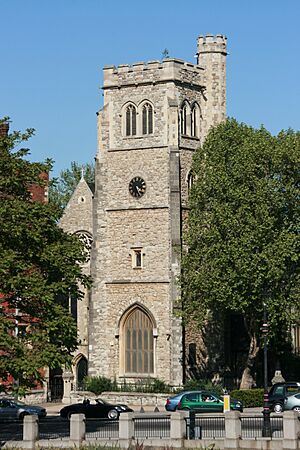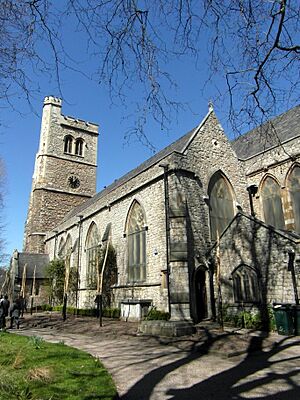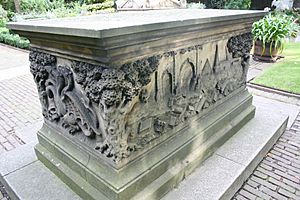Garden Museum facts for kids
The Garden Museum in London is a super cool place! It's the only museum in Britain that teaches you all about the art, history, and design of gardens. Imagine learning how gardens have changed over hundreds of years! The museum got a big makeover and reopened in 2017, looking better than ever.
This amazing museum is inside an old church called St Mary-at-Lambeth. This church was built a long, long time ago, but it was going to be knocked down in 1972. Luckily, a lady named Rosemary Nicholson discovered the tombs of two famous 17th-century gardeners, John Tradescant the Elder and his son the Younger, in the churchyard. This gave her the idea to save the church and create the world's first museum dedicated to gardening history! The museum is right next to Lambeth Palace and overlooks the River Thames.
Inside the museum, the main area for exhibits is on the first floor, where the church used to be. You can see old gardening tools, beautiful art, and lots of interesting things related to gardens. There's even a special section that looks like Tradescant's 17th-century "Ark" – a collection of strange and wonderful objects he gathered. The museum shows you not just how to garden, but also how gardening has been a part of people's lives through history. There are also three special exhibition areas that change every six months, showing different cool things about plants and gardens. As part of the 2017 makeover, two new gardens were created: the Sackler Garden, designed by Dan Pearson, and the front garden by Christopher Bradley-Hole.

Contents
The Museum's Journey
The Garden Museum is a charity, which means it doesn't get money from the government. It relies on donations, visitors, and special events to keep going. In 2002, for its 25th birthday, the museum started a campaign to raise money for improvements.
Phase 1: A New Look (2008)
In 2008, the museum had a big change! Architects from Dow Jones designed new gallery spaces inside the church. This made it a great place for exhibitions and events. The museum was even renamed the Garden Museum and opened its doors again on November 18, 2008.
Phase 2: More Space! (2015–2017)
From 2015 to 2017, the museum had another huge project. They wanted to finish restoring the old church and make it even better as a museum. They received a large grant from the Heritage Lottery Fund to help with this. The museum reopened in 2017 with even more galleries and spaces for learning and events. This second design by Dow Jones Architects also won awards!
This phase doubled the space for showing off the museum's permanent collection. Before, 95% of their amazing items were hidden away! They also created more room for school groups and community projects. Plus, they got a bigger cafe and better services for visitors. A big goal was to create the country's first public archive of garden and landscape design. Now, you can even see a recreation of "Tradescant's Ark" with real objects from his original collection, on loan from the Ashmolean Museum.
The makeover also added a cool viewing platform in the medieval tower. For the first time ever, visitors could climb up and enjoy amazing views across the Thames towards Westminster! In 2020, Dan Pearson designed a new courtyard garden for the museum. He was inspired by modern-day plant explorers, just like the Tradescants were long ago.
St Mary-at-Lambeth Church
The Garden Museum is located inside the historic St Mary-at-Lambeth church. The very first church on this spot was built even before the Norman Conquest in 1066! It was an important religious center for the Archbishops of Canterbury in the 12th century. The church was no longer used in 1972, and it was going to be torn down. But Rosemary Nicholson saved it, and the museum opened in 1977. The churchyard was even redesigned as a beautiful garden.
This church is the oldest building in the London Borough of Lambeth, except for the crypt of Lambeth Palace. It has seen 950 years of history, with many important people buried there. In 1062, a wooden church was built here by Goda, the sister of Edward the Confessor. Later, it was rebuilt with stone and became very grand, serving the Archbishops of Canterbury.
In 1377, the stone tower was built. It was repaired in 1834–1835 but is mostly the same as it was then. You can climb this tower for fantastic views of London! The main part of the church was rebuilt many times over the centuries. In 1851–1852, the aisles and nave (the main body of the church) were almost completely rebuilt by Philip Charles Hardwick. You can still see four interesting stone carvings in the ceiling of the nave, which are a mix of medieval and Victorian styles. Around 1900, a special font for full-body baptisms was added at the base of the tower. It's one of only two like it in Anglican churches in England.
During World War II, bombs badly damaged the church's stained glass windows. In the 1950s, new plain glass or panels replaced them, including a copy of the famous "Pedlar's Window." The bombs also broke the altar that was given to the church in 1888 by Sir Henry Doulton, whose ceramic factory was nearby.
By 1972, the church was in bad shape and not many people lived nearby anymore. So, it was decided the church was no longer needed. However, in 1969, the area around Lambeth Palace was made a special "conservation area" to protect its history. In 1976, Rosemary Nicholson visited to see the Tradescant tomb and was shocked to find the church boarded up for demolition. She quickly set up the Tradescant Trust, which was given a 99-year lease to save the building. Saving this church became a huge project for architectural preservation, and it was successfully turned into the museum we see today.
Churchyard and Burials
The churchyard was a burial ground until 1854, and it's estimated that over 26,000 people are buried there! Many important people chose to be buried inside the church, especially in the chancel (the area near the altar). Two very special tombs are those of Hugh Peyntwyn (died 1504) and John Mompesson (died 1524). These are unique examples of a new style of wall monument from that time.
Other famous people buried inside the church include Elizabeth Boleyn (died 1538), who was the mother of Anne Boleyn. Elias Ashmole (died 1692), who helped start the Ashmolean Museum in Oxford, is also buried here. Later, the singer Nancy Storace was buried inside.
Outside in the churchyard, you can find the tombs of Vice-Admiral Bligh of Bounty fame, and John Sealy from the Coade Stone Manufactory. These tombs, along with the Tradescants', are so important that they are listed as Grade II* buildings. The churchyard was very busy in the 19th century, with 15,900 burials recorded between 1790 and 1810 alone! It was expanded in 1814 but closed in 1854, like many other city churchyards.
The Tradescants' Tomb
Five members of the Tradescant family are buried here: John Tradescant the Elder; John Tradescant the Younger with his two wives, Jane and Hester; and his son, also named John, who passed away at 19. The original design for their tomb from the 17th century can be seen in the Pepys Library in Cambridge, and also at the National Portrait Gallery.
The tomb you see today is actually the third one on the Tradescant grave site, but it looks just like the original design. It was restored in 1853 with money donated by the public.
The tomb has cool carvings on its sides. On the east, you can see the family's coat of arms. On the west, there's a skull and a seven-headed hydra (a mythical monster!). The south side shows broken columns, fancy Corinthian capitals, a pyramid, and ruins. On the north side, you'll find shells, a crocodile, and a view of some Egyptian buildings.
The poem on top of the tomb was written by their friend, John Aubrey:
- Know, stranger, ere thou pass, beneath this stone
- Lie John Tradescant, grandsire, father, son
- The last dy'd in his spring, the other two,
- Liv'd till they had travelled Art and Nature through,
- As by their choice Collections may appear,
- Of what is rare in land, in sea, in air,
- Whilst they (as Homer's Iliad in a nut)
- A world of wonders in one closet shut,
- These famous Antiquarians that had been
- Both Gardeners to the Rose and Lily Queen,
- Transplanted now themselves, sleep here & when
- Angels shall with their trumpets waken men,
- And fire shall purge the world, these three shall rise
- And change this Garden then for Paradise.
There's a fun local legend in Lambeth: if you dance around the tomb twelve times while Big Ben strikes midnight, a ghost is said to appear!
Coffins Found During Renovation
During the museum's renovation work in 2016, workers made an exciting discovery! They found a hidden vault containing 30 coffins. Among them were the coffins of five Archbishops of Canterbury, who are very important leaders of the Church of England. These included Richard Bancroft (who helped with the King James Bible), John Moore, Frederick Cornwallis, Matthew Hutton, and Thomas Tenison. They also identified Catherine Moore, John Moore's wife, and John Bettesworth, a church official.









